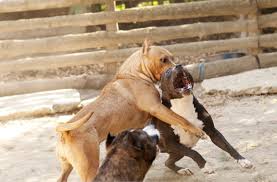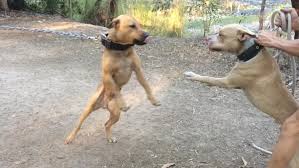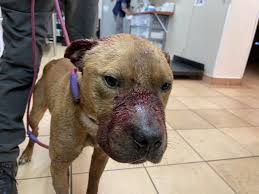
1. Introduction: The Eyes That Haunt
There’s something unforgettable about the eyes of a dog that’s been abused — wide with fear, dulled by suffering, and searching for a kindness they’ve never known. These eyes do not lie. They are silent witnesses to a world many pretend doesn’t exist — a world where dogs are tortured, mutilated, and forced to fight to the death for the amusement and ego of the lowest kind of human. This is the bloodstained underground of illegal dog fighting, a global plague of cruelty that thrives in the shadows.
This article is not for the faint of heart. But it is necessary. It is time to drag this vile world into the light and expose those who orchestrate the suffering: the criminals, the cowards, the egotists who turn loyal animals into tools of violence to inflate their own twisted sense of greatness. Dog fighting is not a sport. It’s not tradition. It’s not culture. It is evil — a cold, calculated system of exploitation that must be eradicated.
2. A Historical Look at Dog Fighting
Dog fighting has existed in some form for centuries. It began as a blood sport in ancient Rome, where dogs were pitted against wild animals for entertainment in brutal arenas. Over time, it evolved into organized canine combat. By the 18th and 19th centuries, Britain and other parts of Europe had embraced it as a pastime for the working class. The practice eventually made its way to the United States, where it became part of a grim subculture in rural areas and urban slums.
While the UK banned dog fighting in 1835, it persisted underground. In America, it remained legal in some regions into the 20th century. Even now, despite being banned in all 50 states and considered a felony, dog fighting continues in hidden basements, abandoned warehouses, and secluded farms. Organized rings, protected by silence and intimidation, keep the blood flowing.
Internationally, dog fighting is still legal or tolerated in some countries. In parts of Asia, Latin America, and Eastern Europe, the laws are weak or nonexistent. Cultural taboos against speaking out — combined with corruption and apathy — allow the abuse to continue unabated.

3. The Criminal Psychology Behind Dog Fighting
Who are the people behind dog fighting? They are not champions. They are not dog lovers. They are not tough men. They are abusers — criminals with fragile egos who mistake violence for strength.
The psychology of a dog fighter is rooted in insecurity and narcissism. They crave dominance, not just over dogs, but over the people around them. They use dogs as symbols of power, forcing them to fight as proxies for their own weakness. Their warped pride is measured in scars and broken bones — not their own, but those of animals they’ve beaten, starved, and brutalized into submission.
Many dog fighters are tied to other forms of crime: drug trafficking, illegal gambling, weapons sales, gang activity. Dog fighting becomes a hub where all these criminal enterprises converge. The brutality of the fights serves as initiation rituals, displays of loyalty, or contests for cash. In these circles, mercy is mocked, and empathy is seen as weakness.
Real strength lies in compassion. Real courage is shown by those who rescue, not those who torture. Those who hide behind a fighting dog are cowards wearing the mask of toughness.

4. How Dogs Are Trained and Tortured for Fights
The path to the fighting ring begins long before the blood is spilled. Dogs are subjected to months, sometimes years, of savage conditioning designed to strip them of natural instincts like affection and playfulness. These animals are not born violent — they are made that way through systematic cruelty.
Training often starts with starvation, keeping dogs hungry to make them aggressive. They are chained on heavy logging chains to build muscle, forced to run on treadmills for hours, and attacked by other dogs to “toughen” them. Trainers use bait animals — smaller, helpless pets stolen from homes or shelters — to awaken the killing instinct. The screams of these victims are just background noise to the abuser.
Electroshock devices, beatings, and isolation are common tools. Dogs are denied any social interaction or comfort. Instead, they are rewarded with praise only when they show aggression. Some are injected with steroids or stimulants to enhance their rage and stamina before fights. Their teeth may be filed to sharp points. Their ears cropped not for appearance, but so an opponent has less to grab onto.
This isn’t training. It’s torture disguised as preparation. Every moment of a fighting dog’s life is saturated with fear, pain, and psychological torment.

5. The Vicious Cycle: Breeding, Selling, and Killing
Behind every dog fight is a supply chain built on misery. Breeding operations — often called “yards” — produce litter after litter of puppies destined for violence. Dogs with a “winning” record are bred endlessly, their genes treated like products. Females are forced to breed repeatedly with no concern for their health or comfort. Once their bodies give out, they are killed or dumped.
Puppies not deemed strong enough for fighting are often sold into other forms of abuse, such as guard dog exploitation or chained backyard neglect. Others are used as bait to train more “promising” fighters.
The marketplace for fighting dogs operates in secrecy: online forums, encrypted messaging apps, and word-of-mouth networks. These criminal breeders charge thousands for dogs with certain bloodlines. They claim “champion stock” as a badge of honor — but what they’re really selling is a creature bred to suffer.
And the horror doesn’t end in the ring. Dogs that lose are often executed in unspeakable ways — drowned, shot, electrocuted, burned alive. Some are simply discarded like trash, left to die alone in a ditch. There is no retirement plan, no second chance. In this vile economy, a dog’s worth is measured only in wins.
6. The Role of Social Media and Online Platforms
In today’s digital world, social media has become a double-edged sword. On one hand, it allows dog fighters to spread propaganda, brag about their “champions,” and even coordinate illegal events using encrypted apps and closed groups. On the other hand, it also provides a window for whistleblowers and rescue groups to expose these crimes.
Videos of fights, dogs posturing, or abused animals covered in scars are sometimes posted as twisted trophies. These posts glorify cruelty and turn suffering into status. Worse, they inspire young, impressionable viewers — often in impoverished communities — to see dog fighting as a path to power or income.
But the same platforms used for evil can be reclaimed. Exposés, documentaries, survivor stories, and advocacy campaigns have reached millions. Organizations are pressuring tech companies to flag and remove content promoting animal cruelty, and to report it to authorities.
We must be vigilant. Report such content. Demand platforms take action. The internet should not be a hunting ground for the sadistic.

7. Famous Cases and Exposures: When the Mask Slips
Dog fighting might thrive in the shadows, but every so often, the mask slips — and the world sees the truth. The most infamous case in recent memory involved NFL quarterback Michael Vick, whose 2007 conviction for running a dog fighting ring shocked the public. His property, known as “Bad Newz Kennels,” was a house of horrors. Dogs were electrocuted, drowned, hanged, and slammed to the ground for underperforming in fights.
Vick served time in federal prison, but his return to football sparked outrage. Though he later apologized and advocated for animal welfare, many never forgave the pain he enabled. More importantly, his case exposed the massive scale of the problem — one that reaches into celebrity circles, law enforcement, and every level of society.
Other busts have uncovered dog fighting rings involving hundreds of participants and multi-state networks. In 2013, the FBI broke up a major ring in Alabama and Georgia, seizing 367 dogs in the second-largest dog fighting raid in U.S. history. The dogs were found chained to car axles, left in scorching heat, starving and dehydrated. The criminals profited not just from gambling but from breeding and selling fighting dogs across state lines.
Each exposure reveals the same pattern: money, ego, and absolute disregard for life. These are not isolated incidents. They are symptoms of a much deeper rot.

8. Law Enforcement and Legal Challenges
While dog fighting is illegal in many countries, enforcement is inconsistent, and the penalties often don’t match the crime. In the U.S., it is a federal felony under the Animal Welfare Act, but prosecution depends on strong evidence — something difficult to obtain when witnesses are afraid to speak and events are hidden in remote locations.
Undercover operations are risky, requiring months or even years of infiltration. Law enforcement officers often face threats, corruption, or lack of resources. In some areas, local police don’t prioritize animal cruelty cases at all.
Even when arrests are made, sentences are often shockingly light. First-time offenders may get a few months in jail or probation. Meanwhile, the animals they abused receive a life sentence of trauma — if they survive at all.
There are, however, signs of progress. The FBI now categorizes animal cruelty as a top-tier felony, allowing for better data collection and inter-agency cooperation. Advocacy groups work closely with law enforcement, training officers to recognize signs of dog fighting during unrelated investigations.
But until the penalties are severe enough to deter, and until society stops viewing animals as property, dog fighting will continue to thrive.
9. Fighting the Fight: Rescue Groups and Heroes on the Ground
Amid the darkness, there are warriors of light. Across the globe, animal rescue organizations risk everything to pull dogs from the jaws of death and give them a second chance. These groups operate with limited funds, facing emotional burnout and bureaucratic hurdles, but they persist because the alternative is unthinkable.
Groups like the ASPCA, Humane Society, and local shelters have teams dedicated to rescuing fighting dogs, providing medical care, rehabilitation, and eventually adoption — when possible. Each rescued dog is a miracle, a soul saved from the brink.
One of the most inspiring stories comes from the “Vicktory Dogs,” the survivors of Michael Vick’s operation. Many of these dogs went on to live happy lives with loving families, proving that even the most abused animals are capable of healing.
Veterinarians, therapists, and trainers work together to help these dogs overcome their trauma. They teach them to trust, to play, to love. It’s a painstaking process, often taking years, but every wag of the tail is a victory against cruelty.
These rescuers are true heroes. They are the answer to the evil of dog fighters — not with fists, but with open arms and fierce compassion.

10. The Role of the Public: Silence Is Complicity
You don’t have to be a criminal to be part of the problem. Indifference, ignorance, and silence are what allow dog fighting to survive. Every time a person turns away from the truth, laughs at a joke about pit bulls, or ignores a chained dog in a neighbor’s yard, they contribute to a culture that devalues animal life.
The public has immense power. It starts with awareness — sharing information, supporting rescue groups, reporting suspected abuse. If you hear dogs barking aggressively behind boarded-up buildings, or notice unusual patterns of visitors at night, or see injured animals being kept in horrific conditions — speak up. Report it. Even anonymous tips can save lives.
Refuse to attend events that exploit animals. Refuse to associate with people who joke about dog fighting. Teach children to respect animals and recognize abuse. Raise your voice. Because in a world where animals cannot testify, your voice might be the only thing between life and death for an innocent creature.
11. Reclaiming the Narrative: Dogs Are Not Weapons
One of the most insidious legacies of dog fighting is the way it has warped public perception of certain breeds — especially pit bulls. These dogs, once celebrated as loyal companions and even “nanny dogs” for children, have been demonized due to their association with fighting.
But pit bulls are not born killers. They are victims of human cruelty. They are loving, playful, deeply emotional animals who suffer the most in this war. By reclaiming their narrative, we fight back against the criminals who’ve used them as symbols of aggression.
We must stop seeing dogs as tools for power, ego, or intimidation. They are not accessories for gangsters or machines for criminals. They are family. They are protectors, companions, healers. The only thing a dog will ever fight for is your love — and they’ll do it with their whole heart.
12. Conclusion: Light in the Darkness
Dog fighting is not just a crime. It is a moral catastrophe. It reveals the darkest corners of human nature — our capacity to dominate, exploit, and destroy that which trusts us the most. But in fighting this evil, we also uncover our capacity for courage, empathy, and change.
The fight to end dog fighting is not over. But every dog rescued, every ring shut down, every law strengthened, and every child taught to love animals instead of fear them — these are steps toward a better world.
The dogs can’t speak for themselves. But we can. We must.
Let their scars be seen. Let their stories be heard. And let their suffering be the reason we never, ever stop fighting for them.

